| Columns Retired Columns & Blogs |
Rogue Audio M-180 monoblock power amplifier Measurements
Sidebar 4: Measurements
I examined the Rogue M-180's measured behavior using mainly Stereophile's loaner sample of the top-of-the-line Audio Precision SYS2722 system (see the January 2008 "As We See It" and www.ap.com); for some tests, I also used my vintage Audio Precision System One Dual Domain.
With two output-transformer taps, two output operating modes (triode and ultralinear), and two inputs (unbalanced and transformer-coupled balanced), the M-180 is basically eight amplifiers in one chassis. After checking the bias, I performed a complete set of measurements from each tap in triode and ultralinear modes, using the balanced input. I then repeated a representative set of measurements using the unbalanced input. Unless I indicate otherwise, the measurements referred to in this sidebar are of balanced drive.
The Rogue's output preserved absolute polarity (ie, was non-inverting) through both inputs and from both transformer taps in both modes. The voltage gain, however, varied according to both mode and tap, though it was the same from both inputs. The maximum gain was from the 8 ohm tap in ultralinear mode, at 31.4dB into 8 ohms. The lowest gain was in triode mode from the 4 ohm tap, at 28.3dB, again into 8 ohms. The input impedance appeared to be the same for both balanced and unbalanced drive, at 78k ohms at 20Hz, rising to 95k ohms at 1kHz but dropping to 18k ohms at 20kHz. The last might roll off the highs a little with tube preamps having a very high source impedance, but should otherwise be benign.
The output impedance depended on the output tap and frequency, but was similar in ultralinear and triode modes. It was actually low for a tubed design—just 0.33 ohm at 1kHz from the 4 ohm tap in both ultralinear and triode modes, though this did rise to 0.57 ohm at 20Hz and 0.9 ohm at 20kHz. From the 8 ohm tap, the output impedance ranged from 0.57 ohm at 1kHz to 1 ohm at 20Hz and 1.2 ohms at 20kHz. The relatively low output impedance meant that any modification of the amplifier's frequency response due to the Ohm's Law interaction between this impedance and the impedance of the loudspeaker remained within ±0.25dB for the 4 ohm tap (fig.1) and within ±0.4dB for the 8 ohm tap (fig.2).
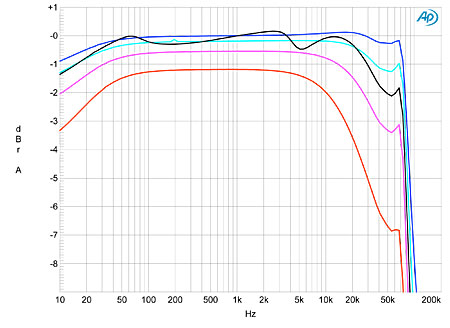
Fig.1 Rogue M-180, ultralinear, 4 ohm tap, frequency response at 2.83V into: simulated loudspeaker load (gray), 16 ohms (blue), 8 ohms (cyan), 4 ohms (magenta), 2 ohms (red). (1dB/vertical div.)
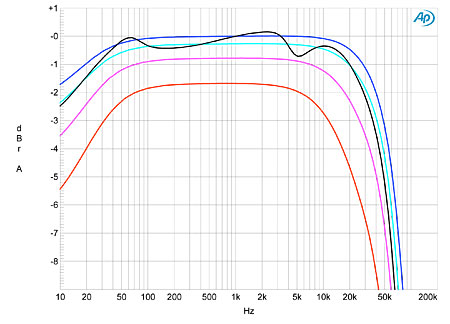
Fig.2 Rogue M-180, triode, 8 ohm tap, frequency response at 2.83V into: simulated loudspeaker load (gray), 16 ohms (blue), 8 ohms (cyan), 4 ohms (magenta), 2 ohms (red). (1dB/vertical div.)
The M-180's frequency response also depended on both the output tap and the operational mode. Fig.1 shows the response in ultralinear mode from the 4 ohm tap; a residual peak is apparent at 68kHz but is counteracted by the increasing rolloff as the load impedance decreases. In the worst case, into 2 ohms, the response is down 2.4dB at 20kHz. The low frequencies also roll off more with decreasing load, but not to any significant extent. There is no sign of any ultrasonic response peaking in triode mode (fig.2). The 10kHz squarewave response in ultralinear mode (fig.3) shows that the ultrasonic response peak is associated with a single cycle of damped oscillation; as expected, the 10kHz waveform in triode mode is free from ringing (fig.4), while a 1kHz squarewave is reproduced in textbook fashion, with sharp corners and flat tops (fig.5).
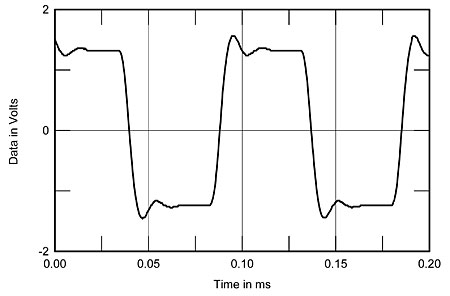
Fig.3 Rogue M-180, ultralinear, 8 ohm tap, small-signal 10kHz squarewave into 8 ohms.
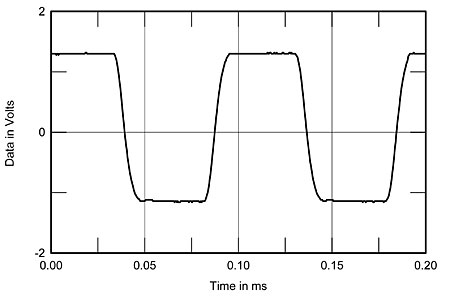
Fig.4 Rogue M-180, triode, 8 ohm tap, small-signal 10kHz squarewave into 8 ohms.
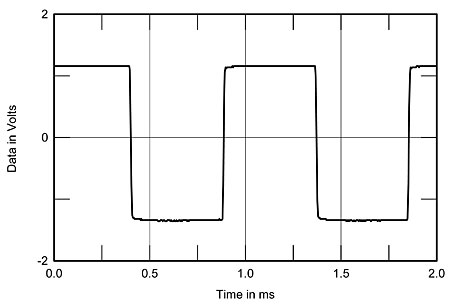
Fig.5 Rogue M-180, triode, 8 ohm tap, small-signal 1kHz squarewave into 8 ohms.
The Rogue M-180 is not the quietest of amplifiers; its unweighted, wideband signal/noise ratio (ref. 1W into 8 ohms, with the input shorted) measured 71.2dB from the 8 ohm tap in ultralinear mode, 74dB in triode mode. The measurements were about 2.5dB better from the 4 ohm tap. Restricting the measurement to the audioband improved the ratio to 77.3dB/80dB, while A-weighting the measurement gave a figure of 92.3dB/95dB.
How the M-180's THD+noise percentage varies with output power into loads ranging from 2 to 16 ohms is shown in figs.6–9 (respectively: ultralinear mode, 8 ohm tap; ultralinear, 4 ohm tap; triode, 8 ohm tap; triode, 4 ohm tap). Visible in these four graphs are some common factors: the linear rise in THD with power suggests a low amount of loop negative feedback; the lowest distortion occurs around 500mW with each tap driving as high an impedance as possible; the amplifier doesn't actually clip into 2 ohms from both taps or into 4 ohms from the 8 ohm tap until the distortion is well above the 1% threshold we usually define as clipping; ultralinear operation gives usefully more power than triode; and the maximum power is obtained with the nominal output tap impedance matched to the load. The maximum power delivery (1% THD+N) was 160W from the 8 ohm tap into 8 ohms in ultralinear mode (22dBW), 88W in triode mode (19.5dBW), 140W from the 4 ohm tap into 4 ohms in ultralinear mode (18.5dBW), and 87W in triode mode (16.4dBW). The Rogue does meet its specified maximum output of 180W in ultralinear mode (22.6dBW into 8 ohms) but at a relaxed 3% THD limit.
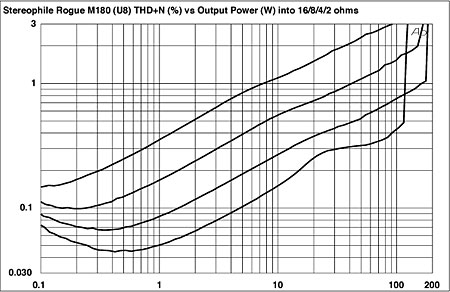
Fig.6 Rogue M-180, ultralinear, 8 ohm tap, distortion (%) vs 1kHz continuous output power into (from bottom to top): 16, 8, 4, 2 ohms.
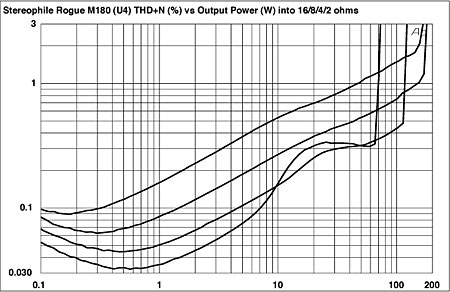
Fig.7 Rogue M-180, ultralinear, 4 ohm tap, distortion (%) vs 1kHz continuous output power into (from bottom to top): 16, 8, 4, 2 ohms.
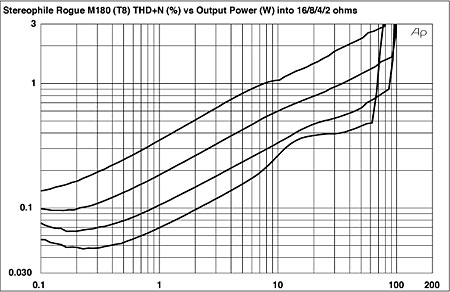
Fig.8 Rogue M-180, triode, 8 ohm tap, distortion (%) vs 1kHz continuous output power into (from bottom to top): 16, 8, 4, 2 ohms.
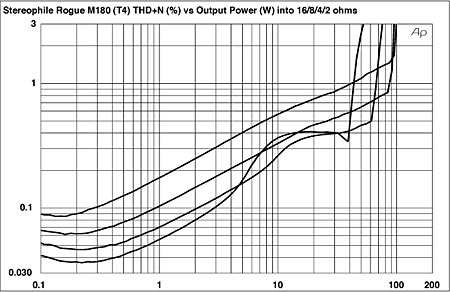
Fig.9 Rogue M-180, triode, 4 ohm tap, distortion (%) vs 1kHz continuous output power into (from bottom to top): 16, 8, 4, 2 ohms.
While the Rogue's midband distortion was respectably low at low powers, it did rise at higher frequencies and into lower impedances. Fig.10, for example, shows how the small-signal THD+N percentage changes with frequency into loads ranging from 2 ohms (red trace) to 16 ohms (blue), with the amplifier in ultralinear mode and connected from the 4 ohm tap. The low- and mid-frequency distortion is very low into 16 and 8 ohms (blue and cyan traces), but starts to rise above 0.1% in the midrange into 4 ohms (magenta). And the distortion rises rapidly above 5kHz into all loads, implying poor HF linearity. The picture was not too different in triode mode (fig.11), except that the HF distortion now starts to rise above 2kHz rather than 5kHz. From the 8 ohm tap (not shown), distortion was around twice that from the 4 ohm tap in both modes, but was otherwise very similar in content.
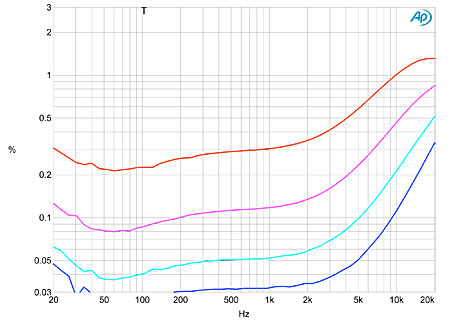
Fig.10 Rogue M-180, ultralinear, 4 ohm tap, THD+N (%) vs frequency at 2.83V into: 16 ohms (blue), 8 ohms (cyan), 4 ohms (magenta), 2 ohms (red).
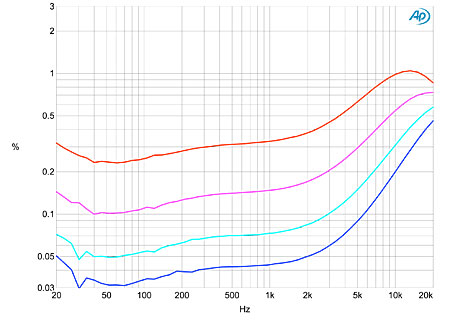
Fig.11 Rogue M-180, triode, 4 ohm tap, THD+N (%) vs frequency at 2.83V into: 16 ohms (blue), 8 ohms (cyan), 4 ohms (magenta), 2 ohms (red).
Fortunately, at moderate power levels, the distortion in both modes from both transformer taps was predominantly the subjectively innocuous second harmonic (fig.12). At higher powers in ultralinear mode, the second harmonic remained the strongest but was joined by a regular harmonic series decreasing with increasing order (fig.13). In triode mode at the same high power (fig.14), the third harmonic became as strong as the second.
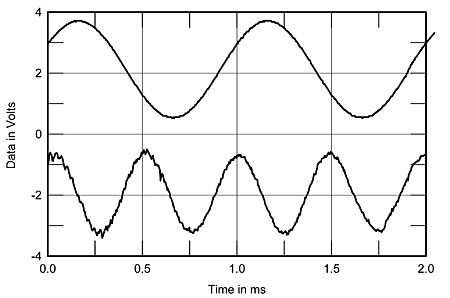
Fig.12 Rogue M-180, triode, 8 ohm tap, 1kHz waveform at 1.6W into 8 ohms (top), 0.074% THD+N; distortion and noise waveform with fundamental notched out (bottom, not to scale).
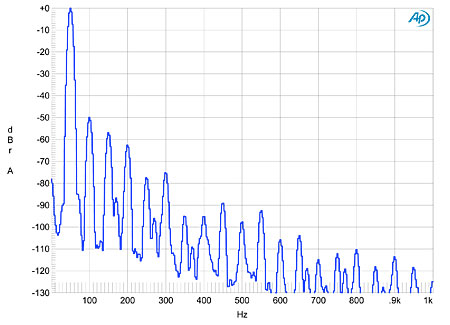
Fig.13 Rogue M-180, ultralinear, 4 ohm tap, spectrum of 50Hz sinewave, DC–1kHz, at 50W into 8 ohms (linear frequency scale).
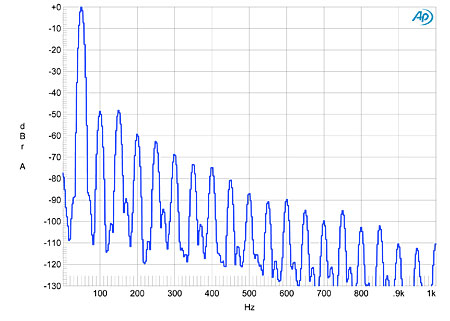
Fig.14 Rogue M-180, triode, 4 ohm tap, spectrum of 50Hz sinewave, DC–1kHz, at 50W into 8 ohms (linear frequency scale).
The poor top-octave linearity seen in figs. 10 and 11 leads to a disappointing performance on the high-frequency intermodulation test, with similar spectra seen from both modes from both taps. Fig.15, for example, shows the spectrum taken from the 8 ohm tap in triode mode; the second-order difference component lies at –36dB (1.5%), while many higher-order spuriae are visible. Reducing the power level from 50W to 1W eliminated all the high-order components (Fig.16), but the difference tone still lay at a marginally acceptable –54dB (0.2%).
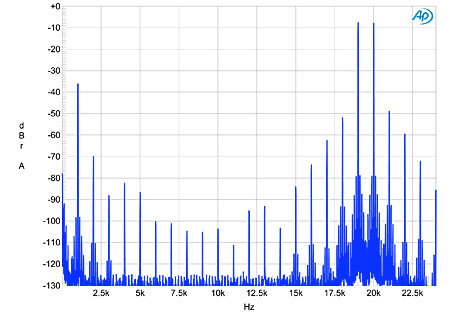
Fig.15 Rogue M-180, triode, 8 ohm tap, HF intermodulation spectrum, DC–24kHz, 19+20kHz at 50W peak into 8 ohms (linear frequency scale).
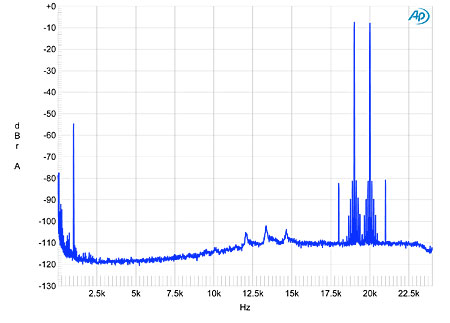
Fig.16 Rogue M-180, triode, 8 ohm tap, HF intermodulation spectrum, DC–24kHz, 19+20kHz at 1W peak into 8 ohms (linear frequency scale).
The M-180's poor top-octave linearity basically stems from the decision to use as little loop negative feedback as possible, as many designers feel that this gives the best sound quality. But the Rogue still offers excellent linearity at low levels, where the amplifier will typically be operating with naturally recorded music. Triode mode is slightly less well behaved than ultralinear, and this might underlie EL's preference for ultralinear operation. I am impressed by the M-180's superb squarewave reproduction in triode mode, as well as by its low output impedance in both modes, which imply excellent transformer design. However, its measured performance does suggest that the M-180 will work optimally when matched to speakers with a nominal impedance equal to or greater than the nominal value of the chosen transformer tap.—John Atkinson
- Log in or register to post comments



































